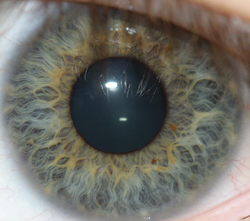Iris recognition is an automated method of biometric identification that uses mathematical pattern-recognition techniques on video images of one or both of the irises of an individual’s eyes, whose complex patterns are unique, stable, and can be seen from some distance.
Retinal scanning is a different, ocular-based biometric technology that uses the unique patterns on a person’s retina blood vessels and is often confused with iris recognition. Iris recognition uses video camera technology with subtle near infrared illumination to acquire images of the detail-rich, intricate structures of the iris which are visible externally. Digital templates encoded from these patterns by mathematical and statistical algorithms allow the identification of an individual or someone pretending to be that individual.[1] Databases of enrolled templates are searched by matcher engines at speeds measured in the millions of templates per second per (single-core) CPU, and with remarkably low false match rates.
Several hundred million persons in several countries around the world have been enrolled in iris recognition systems for convenience purposes such as passport-free automated border-crossings and some national ID programs. A key advantage of iris recognition, besides its speed of matching and its extreme resistance to false matches, is the stability of the iris as an internal and protected, yet externally visible organ of the eye.
How It’s Works
Iris scanning can seem very futuristic, but at the heart of the system is a simple CCD digital camera. It uses both visible and near-infrared light to take a clear, high-contrast picture of a person’s iris. With near-infrared light, a person’s pupil is very black, making it easy for the computer to isolate the pupil and iris.
When you look into an iris scanner, either the camera focuses automatically or you use a mirror or audible feedback from the system to make sure that you are positioned correctly. Usually, your eye is 3 to 10 inches from the camera. When the camera takes a picture, the computer locates:
- The center of the pupil
- The edge of the pupil
- The edge of the iris
- The eyelids and eyelashes
It then analyzes the patterns in the iris and translates them into a code.
An iris scanner

PHOTO COURTESY IRIDIAN TECHNOLOGIES
Iris scanners are becoming more common in high-security applications because people’s eyes are so unique (the chance of mistaking one iris code for another is 1 in 10 to the 78th power [ref]. They also allow more than 200 points of reference for comparison, as opposed to 60 or 70 points in fingerprints.
The iris is a visible but protected structure, and it does not usually change over time, making it ideal for biometric identification. Most of the time, people’s eyes also remain unchanged after eye surgery, and blind people can use iris scanners as long as their eyes have irises. Eyeglasses and contact lenses typically do not interfere or cause inaccurate readings.

